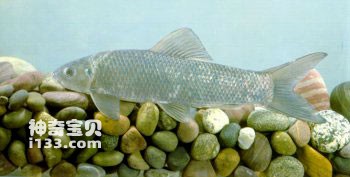Sinilabeo rendahli belongs to the order Cypriniformes, Cyprinidae, subfamily Sinilabeo, and genus Sinilabeo. Commonly known as: Qinglong stick, peach blossom stick, wild dace, Qingyizi.
The body is long, slightly rod-shaped, and the tail peduncle is high and broad. The snout is blunt, round and protruding, the mouth is inferior and has a transverse cleft. The front of the upper lip is smooth, covered by free kiss skin, with small papillae on both sides; the inner edge of the free part of the lower lip has many small papillae, the lower lip is separated from the mandible, separated by a deep groove, and the upper lip is the upper lip. included. There is a pair of short jaw barbels, and the kiss barbels are often degenerated. There are 45-47 lateral line scales. The back and sides of the body are blue-black, the scales are purple-green with red and metallic luster; the abdomen is yellowish, and each fin is gray-black.

The Chinese dace inhabits rivers and mountain streams with rapid currents. It is a bottom-dwelling fish and likes to live in groups. It often appears in rock gaps and forages on the gravel bottom substrate. It uses the sharp horny edges of its mandibles to scrape algae. It also eats branches, leaves and debris of higher plants. After winter comes, dozens or even hundreds of Chinese barbels spend the winter in deep water caves and seldom go out. Sexual maturity occurs at the age of 2 years. Broodstock swarm into tributaries to spawn from April to June, and the spawning grounds are at the end of rapids shoals with gravel bottoms.
Distributed in the main stream and major tributaries of the upper reaches of the Yangtze River, especially in mountain streams with rapid water flow and clear water quality in the eastern Sichuan Basin.
It grows slowly, with an average individual weighing 1-2 kilograms, and the largest individual can reach 5 kilograms. The yield is high in the place of origin, and it is a common edible fish in Sichuan Province. Its meat is firm, crisp and tender, very delicious and rich in oil, similar to herring, and is regarded as a precious food.
There are 11 related species of Sinilabeo tungting, among which Sinilabeo tungting (commonly known as: dragon fish, dragon pike, herring) is distributed in the Jingjiang section of the Yangtze River in Hubei, Dongting Lake in Hunan, and the Yuanjiang River system; Guihua tungting (Sinilabeo decorus, commonly known as: Qingyi), is distributed in Xijiang and Beijiang of the Pearl River system. Their morphological difference is only that the number of lateral line scales is 39-44, and their living habits and economic value are similar to those of the Chinese dace. But the reproductive season is earlier, from March to April in the Pearl River Basin. It is said that this kind of fish produced in Agarwood Lake in Xinhe Commune, Guangxi has an agarwood flavor, so it is also named "Agarwood Fish".
The Chinese dace and its related species are called "bamboo fish" after removing the internal organs and muscles of the dace. Its fresh fish meat is used as medicine, which has the effects of replenishing qi, neutralizing and removing dampness. It is mainly used to treat chronic illness, physical weakness, waist and leg pain and other diseases.
animal tags:
We created this article in conjunction with AI technology, then made sure it was fact-checked and edited by a Animals Top editor.